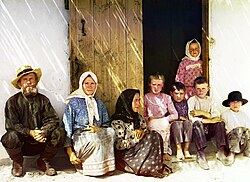Russians in Azerbaijan

A family of Russian settlers in the Mughan steppe of Azerbaijan (early 20th century)
|
|
| Total population | |
|---|---|
| (119,300 (2009 census)) | |
| Regions with significant populations | |
| Baku, Ganja, Sumqayit, Ismayilli, Khachmaz | |
| Languages | |
| Russian, Azeri | |
| Religion | |
| Eastern Orthodox Christianity |
Russians (Azerbaijani: Azərbaycanda ruslar / Азәрбајҹанда руслар, Russian: русские в Азербайджане; russkie v Azerbajdžane) are the second largest ethnic minority in Azerbaijan and is also the largest Russian community in the South Caucasus and one of the largest outside of Russia. Although in decline, the community still numbers 119,300 people as of 2009. Since their arrival at the beginning of the 19th century, the Russians have played an important role in all spheres of life, particularly during the Czarist and Soviet period, especially in the capital the city of Baku.
Although a Cossack outpost near Lankaran already existed in 1795, the first Russian civilian settlers in Azerbaijan arrived only between 1830 and 1850, after the ratification of the Treaty of Turkmenchay. In 1832, the forced transmigration of Russian Old Believers and so-called 'sectarians' from the inner provinces of Russia to the South Caucasus began. In the mid-1830s ethnic Russians from the governorates of Tambov, Voronezh, and Samara began to arrive in the Shamakhy and Shusha uyezds, establishing the settlements of Vel, Privolnoye, Prishib, Nikolaevka, and İvanovka. For some time, the 'sectarians' were forbidden to settle in cities, until later when they founded neighbourhoods in Shamakhy and Lankaran. In 1859 they were allowed to settle in Baku. According to census records, by 1897, the Russian-speaking population of the Baku Governorate was 73,632; another large population of Russians was centered on Elisabethpol (modern Ganja), with a population of 14,146.
...
Wikipedia
